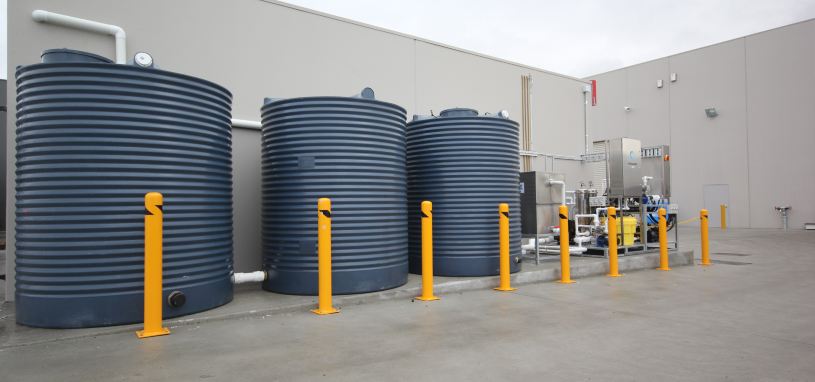Which rainwater harvesting system is right for me?
Australia is known to be one of the driest continents on earth, and as such, freshwater is a precious resource. Rainwater harvesting is one way to capture water for use on an industrial or commercial site and reduce dependence on municipal water supply.
Typical users include wash bays, irrigation or site watering, dust suppression for mining sites, and top up source water for recycling systems.,
Cleanawater offers custom rainwater harvesting solutions for a wide range of applications. Call now for expert advice on custom systems for your business.
What is rainwater harvesting?

Rainwater harvesting is a system for collecting the rain that falls onto roofed or hardstand areas for use in industrial or commercial applications. The alternative is to allow that rainwater to flow into stormwater drain into rivers or the ocean. Unless rainwater is harvested and collected, it returns to the environment, and its usefulness is lost.
Rainwater harvesting systems consist of these components:
- The surface area on which the rain falls (roof or hardstand)
- Tanks to collect the water
- Cleaning and sterilising units to prepare the water for safe use
- Pumps and piping to transport the water
Above ground versus below ground systems
Above ground

Above ground systems use water tanks on the ground surface to collect rainwater. These systems are often used when collecting rainwater from a roof because the water can be piped from gutters into the tanks.
Above ground systems are easy to install and do not require any civil construction to implement. The simplicity of working above ground means the implementation is quicker, and the system can be operational without delay.
However, above ground tanks are large and take up a significant surface area. This makes them unsuitable for high volume installations because the number of tanks and the ground area they occupy would not be practical.
Below ground
Below ground systems require excavation to create underground storage space for the collected rainwater. Relevant construction plans and permits can be necessary, and the construction can be slower.
The advantage of below ground rainwater harvesting is that the system does not occupy much surface ground, leaving space for other activities. With storage below ground, it is also easier to allow rainwater to flow from hardstand areas into the rainwater tanks under the influence of gravity. It makes sense to build the below ground rainwater harvesting system together with the hardstand area where possible, but it can be added later if necessary.
Treating dirty rainwater
Rainwater itself is generally clean and uncontaminated unless the region is known for pollution and acid rain. However, rain falling on a hardstand area can pick up dirt and oil, which could be harmful to all. Contaminants could also damage cars if this water is being used for a car wash, which is often the case.
Fortunately, there are treatment options to solve these problems. While not every stage may be necessary, the following list of options cover most situations:
1. Solids removal
Silt traps or filters capture solid particles. This prevents a build up of solids in the tank and limits the damage to pumps and piping caused by abrasive materials.
2. Oil removal
Oil water separators are the standard equipment for removing hydrocarbons from water. Different options are available depending on the amount of oil present and the volume of water throughput. Many hardstand areas will have traces of oil on them due to vehicle traffic. It is worth checking the collected water quality to check whether an oil water separator will be necessary.
3. Sterilisation
Untreated rainwater in a tank has the potential to grow algae. This organic material can cause odours and could also block up strainers and pumps. For this reason, rainwater systems should be supplied with some form of sterilisation like chlorination, UV, or ozone.
Cleanawater rainwater harvesting solutions
Cleanawater supplies several rainwater harvesting solutions, including above ground and below ground solutions. Their technical experts can help you analyse your needs and recommend the best solution for your application. Storage capacity ranges from 1,000 to 1,000,000 litres, with the larger systems generally being below ground. Overflow systems allow excess rainwater to discharge into the stormwater drain.
Dedicated treatment systems are skid-mounted or containerised, making them easy to install, maintain and replenish as necessary. Cleanawater supply all modules in isolation, not just oil separators meaning that we are a one-stop shop for rainwater harvesting.
Talk to Cleanawater for expert advice
Contact Cleanawater for expert advice about above ground and below ground rainwater harvesting. Our technical experts help you through each step of the process, from identifying your needs to designing custom solutions. We also supply water treatment systems like oil water separators and sterilisation units.
Contact Cleanawater to find out more about our above ground and below ground rainwater harvesting systems.
Must Read
What to Expect During a Modular Wash Bay Installation
CleanaWater, we make the process of installing a modular wash bay on your site as smooth and straightforward as possible. ...
Read moreThe CleanaWater Team Driving Water Treatment and Sustainability
CleanaWater is powered by a dedicated team of professionals who bring expertise and passion to every project. ...
Read more